Cost Management Plan and Analysis for the Bunglow Project, PROJ6002
VerifiedAdded on 2023/03/17
|7
|1130
|71
Report
AI Summary
This report details a cost management plan for a Bunglow project, focusing on cost estimation, budgeting, and control. The plan includes the initial budget of $139,210.00, along with the use of a Gantt chart for tracking progress and managing time. The report covers essential cost management techniques such as time management, inventory management, and outsourcing. It also highlights the importance of cost control through document expense forms and subdividing the project into smaller segments. The report emphasizes the importance of tracking costs, utilizing tools like ROI and cash flow analysis, and the impact of labor costs on the overall budget. The document provides a comprehensive overview of cost management strategies applicable to construction projects, aiming to ensure projects are completed on time and within budget.
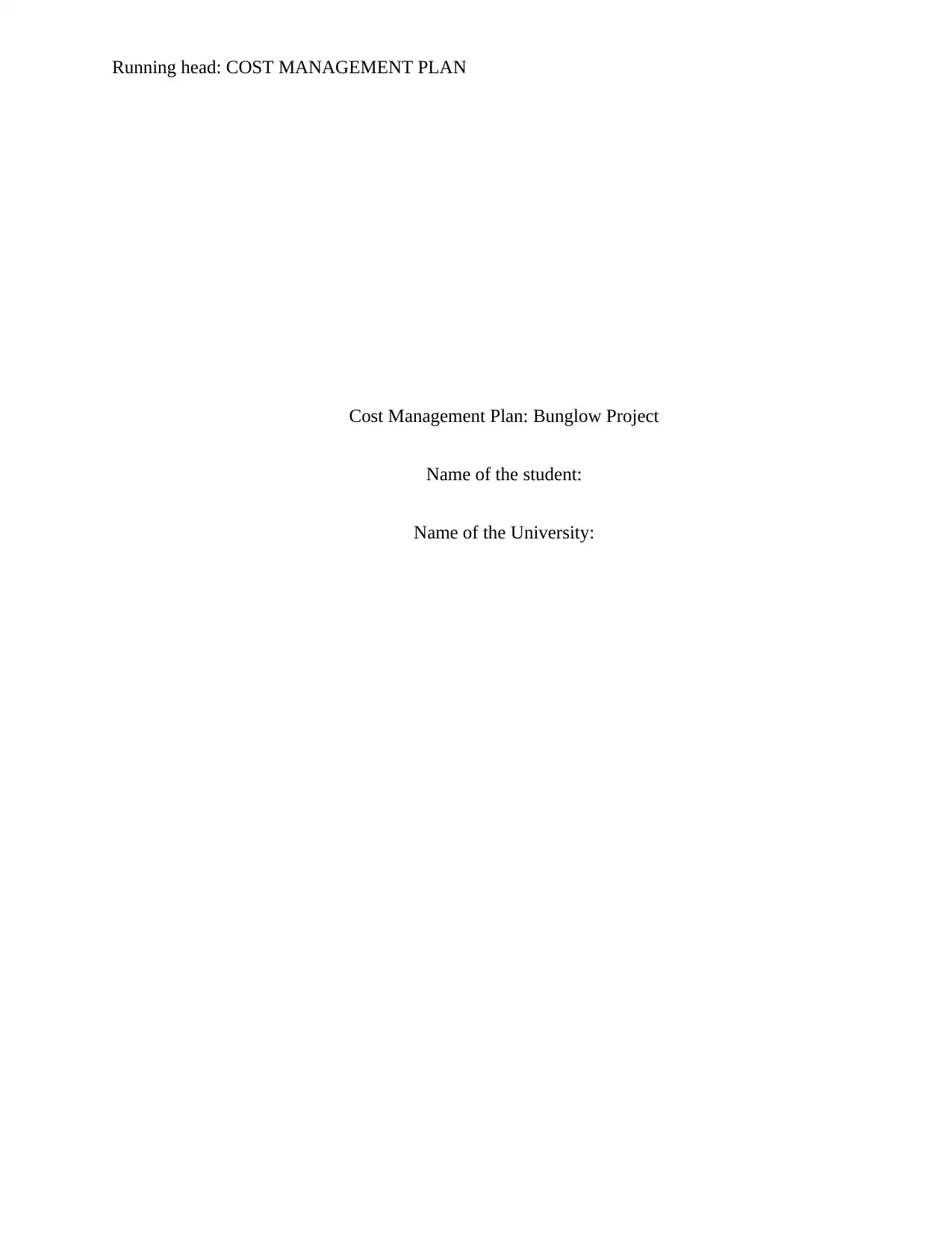
Running head: COST MANAGEMENT PLAN
Cost Management Plan: Bunglow Project
Name of the student:
Name of the University:
Cost Management Plan: Bunglow Project
Name of the student:
Name of the University:
Paraphrase This Document
Need a fresh take? Get an instant paraphrase of this document with our AI Paraphraser
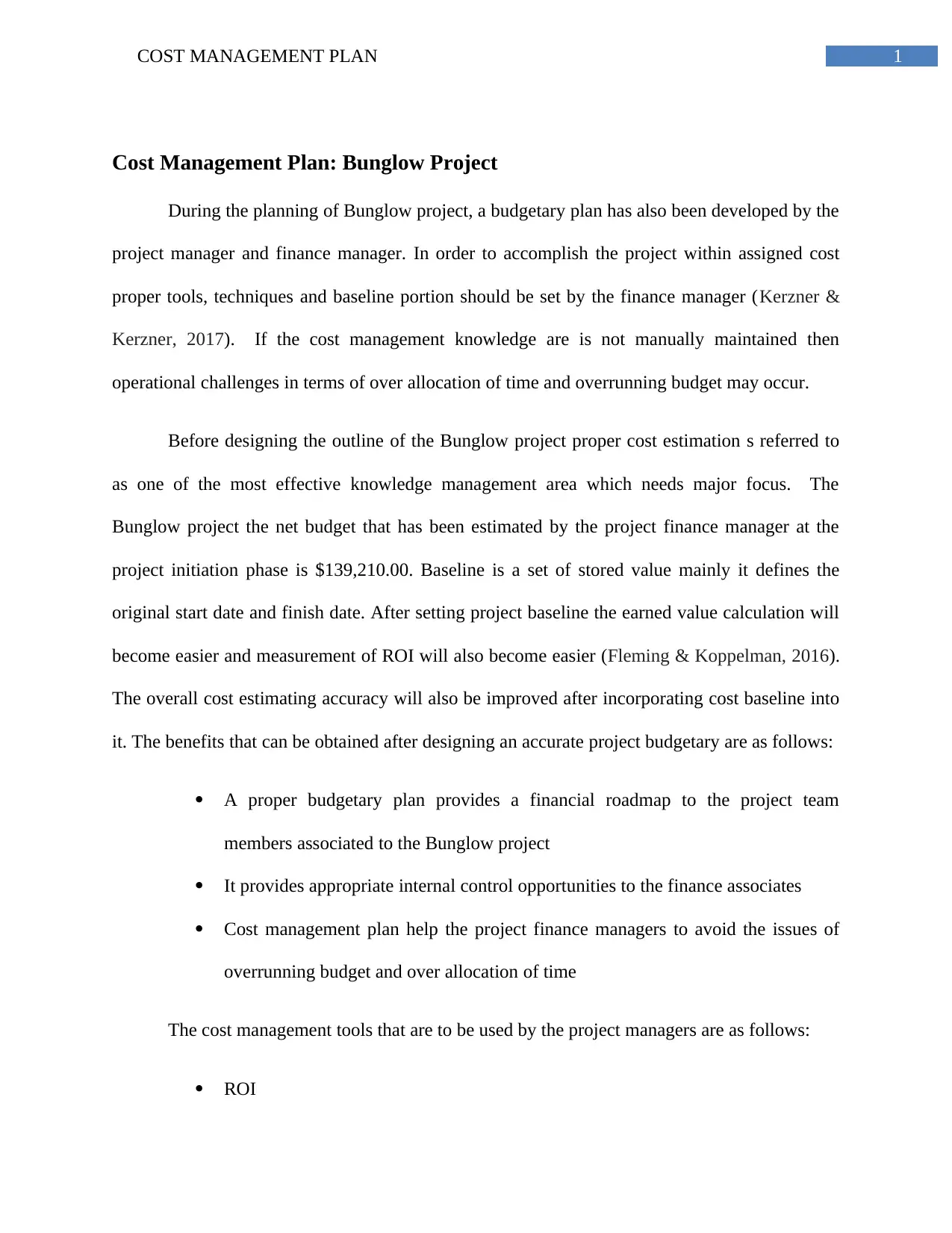
1COST MANAGEMENT PLAN
Cost Management Plan: Bunglow Project
During the planning of Bunglow project, a budgetary plan has also been developed by the
project manager and finance manager. In order to accomplish the project within assigned cost
proper tools, techniques and baseline portion should be set by the finance manager (Kerzner &
Kerzner, 2017). If the cost management knowledge are is not manually maintained then
operational challenges in terms of over allocation of time and overrunning budget may occur.
Before designing the outline of the Bunglow project proper cost estimation s referred to
as one of the most effective knowledge management area which needs major focus. The
Bunglow project the net budget that has been estimated by the project finance manager at the
project initiation phase is $139,210.00. Baseline is a set of stored value mainly it defines the
original start date and finish date. After setting project baseline the earned value calculation will
become easier and measurement of ROI will also become easier (Fleming & Koppelman, 2016).
The overall cost estimating accuracy will also be improved after incorporating cost baseline into
it. The benefits that can be obtained after designing an accurate project budgetary are as follows:
A proper budgetary plan provides a financial roadmap to the project team
members associated to the Bunglow project
It provides appropriate internal control opportunities to the finance associates
Cost management plan help the project finance managers to avoid the issues of
overrunning budget and over allocation of time
The cost management tools that are to be used by the project managers are as follows:
ROI
Cost Management Plan: Bunglow Project
During the planning of Bunglow project, a budgetary plan has also been developed by the
project manager and finance manager. In order to accomplish the project within assigned cost
proper tools, techniques and baseline portion should be set by the finance manager (Kerzner &
Kerzner, 2017). If the cost management knowledge are is not manually maintained then
operational challenges in terms of over allocation of time and overrunning budget may occur.
Before designing the outline of the Bunglow project proper cost estimation s referred to
as one of the most effective knowledge management area which needs major focus. The
Bunglow project the net budget that has been estimated by the project finance manager at the
project initiation phase is $139,210.00. Baseline is a set of stored value mainly it defines the
original start date and finish date. After setting project baseline the earned value calculation will
become easier and measurement of ROI will also become easier (Fleming & Koppelman, 2016).
The overall cost estimating accuracy will also be improved after incorporating cost baseline into
it. The benefits that can be obtained after designing an accurate project budgetary are as follows:
A proper budgetary plan provides a financial roadmap to the project team
members associated to the Bunglow project
It provides appropriate internal control opportunities to the finance associates
Cost management plan help the project finance managers to avoid the issues of
overrunning budget and over allocation of time
The cost management tools that are to be used by the project managers are as follows:
ROI
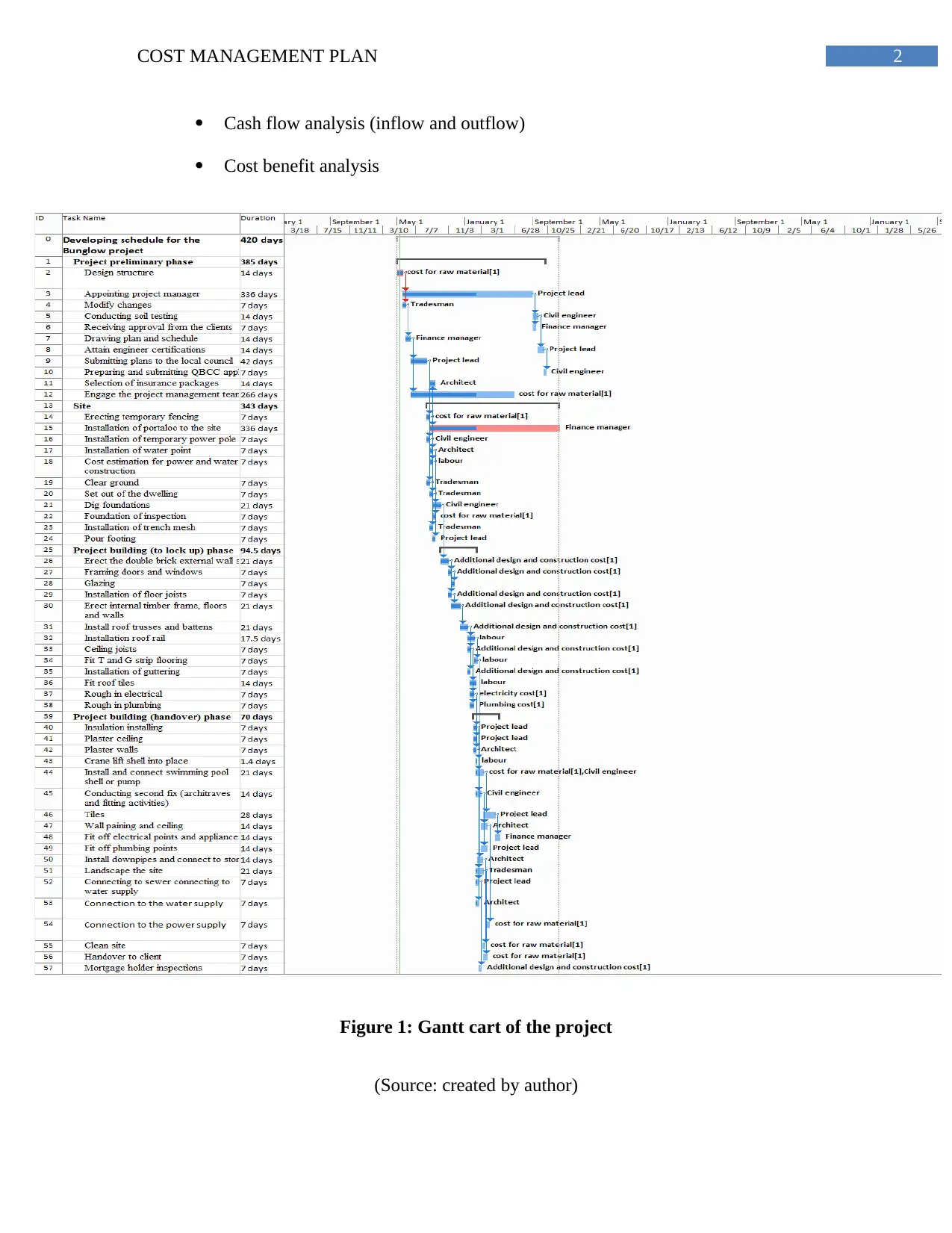
2COST MANAGEMENT PLAN
Cash flow analysis (inflow and outflow)
Cost benefit analysis
Figure 1: Gantt cart of the project
(Source: created by author)
Cash flow analysis (inflow and outflow)
Cost benefit analysis
Figure 1: Gantt cart of the project
(Source: created by author)
⊘ This is a preview!⊘
Do you want full access?
Subscribe today to unlock all pages.

Trusted by 1+ million students worldwide
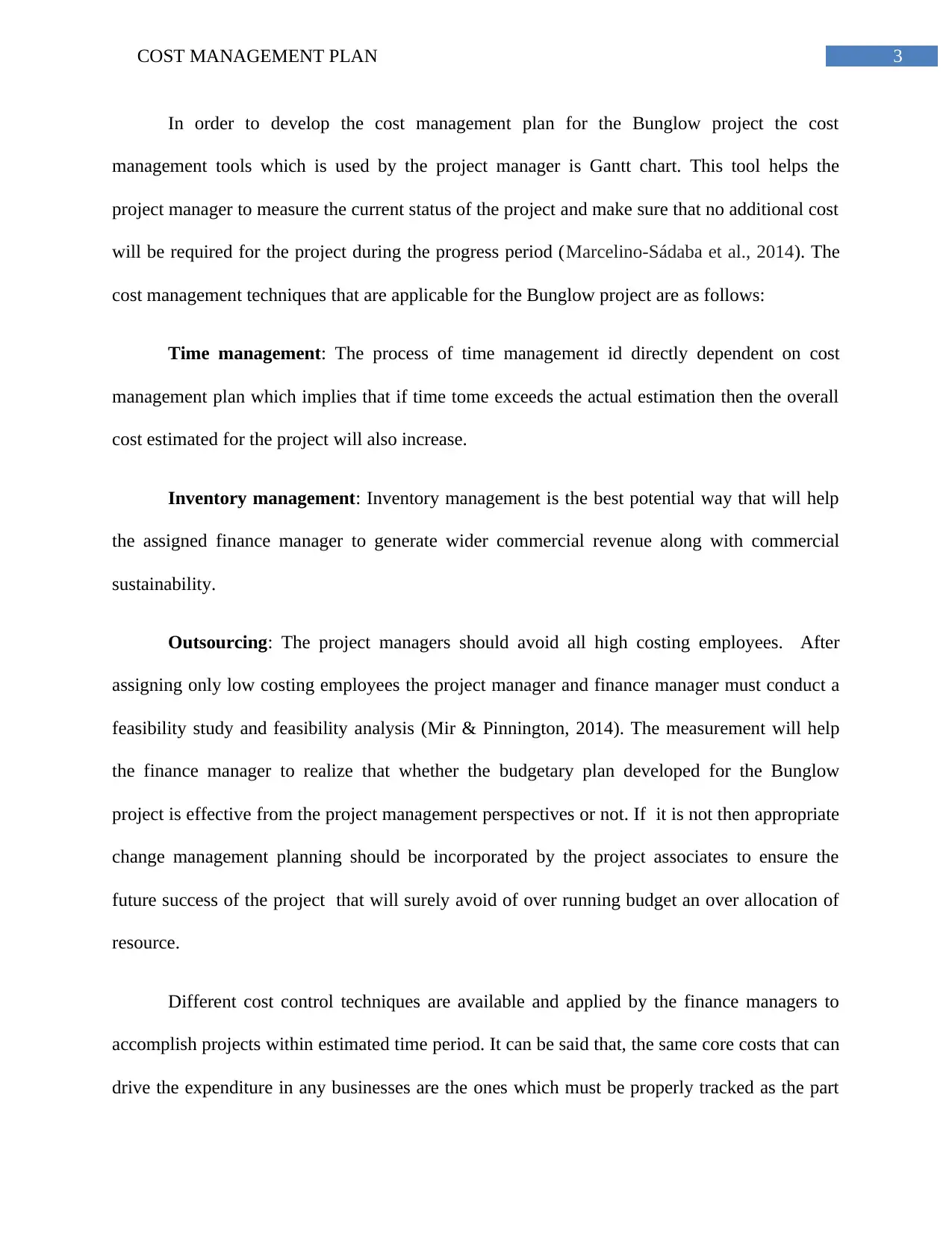
3COST MANAGEMENT PLAN
In order to develop the cost management plan for the Bunglow project the cost
management tools which is used by the project manager is Gantt chart. This tool helps the
project manager to measure the current status of the project and make sure that no additional cost
will be required for the project during the progress period (Marcelino-Sádaba et al., 2014). The
cost management techniques that are applicable for the Bunglow project are as follows:
Time management: The process of time management id directly dependent on cost
management plan which implies that if time tome exceeds the actual estimation then the overall
cost estimated for the project will also increase.
Inventory management: Inventory management is the best potential way that will help
the assigned finance manager to generate wider commercial revenue along with commercial
sustainability.
Outsourcing: The project managers should avoid all high costing employees. After
assigning only low costing employees the project manager and finance manager must conduct a
feasibility study and feasibility analysis (Mir & Pinnington, 2014). The measurement will help
the finance manager to realize that whether the budgetary plan developed for the Bunglow
project is effective from the project management perspectives or not. If it is not then appropriate
change management planning should be incorporated by the project associates to ensure the
future success of the project that will surely avoid of over running budget an over allocation of
resource.
Different cost control techniques are available and applied by the finance managers to
accomplish projects within estimated time period. It can be said that, the same core costs that can
drive the expenditure in any businesses are the ones which must be properly tracked as the part
In order to develop the cost management plan for the Bunglow project the cost
management tools which is used by the project manager is Gantt chart. This tool helps the
project manager to measure the current status of the project and make sure that no additional cost
will be required for the project during the progress period (Marcelino-Sádaba et al., 2014). The
cost management techniques that are applicable for the Bunglow project are as follows:
Time management: The process of time management id directly dependent on cost
management plan which implies that if time tome exceeds the actual estimation then the overall
cost estimated for the project will also increase.
Inventory management: Inventory management is the best potential way that will help
the assigned finance manager to generate wider commercial revenue along with commercial
sustainability.
Outsourcing: The project managers should avoid all high costing employees. After
assigning only low costing employees the project manager and finance manager must conduct a
feasibility study and feasibility analysis (Mir & Pinnington, 2014). The measurement will help
the finance manager to realize that whether the budgetary plan developed for the Bunglow
project is effective from the project management perspectives or not. If it is not then appropriate
change management planning should be incorporated by the project associates to ensure the
future success of the project that will surely avoid of over running budget an over allocation of
resource.
Different cost control techniques are available and applied by the finance managers to
accomplish projects within estimated time period. It can be said that, the same core costs that can
drive the expenditure in any businesses are the ones which must be properly tracked as the part
Paraphrase This Document
Need a fresh take? Get an instant paraphrase of this document with our AI Paraphraser
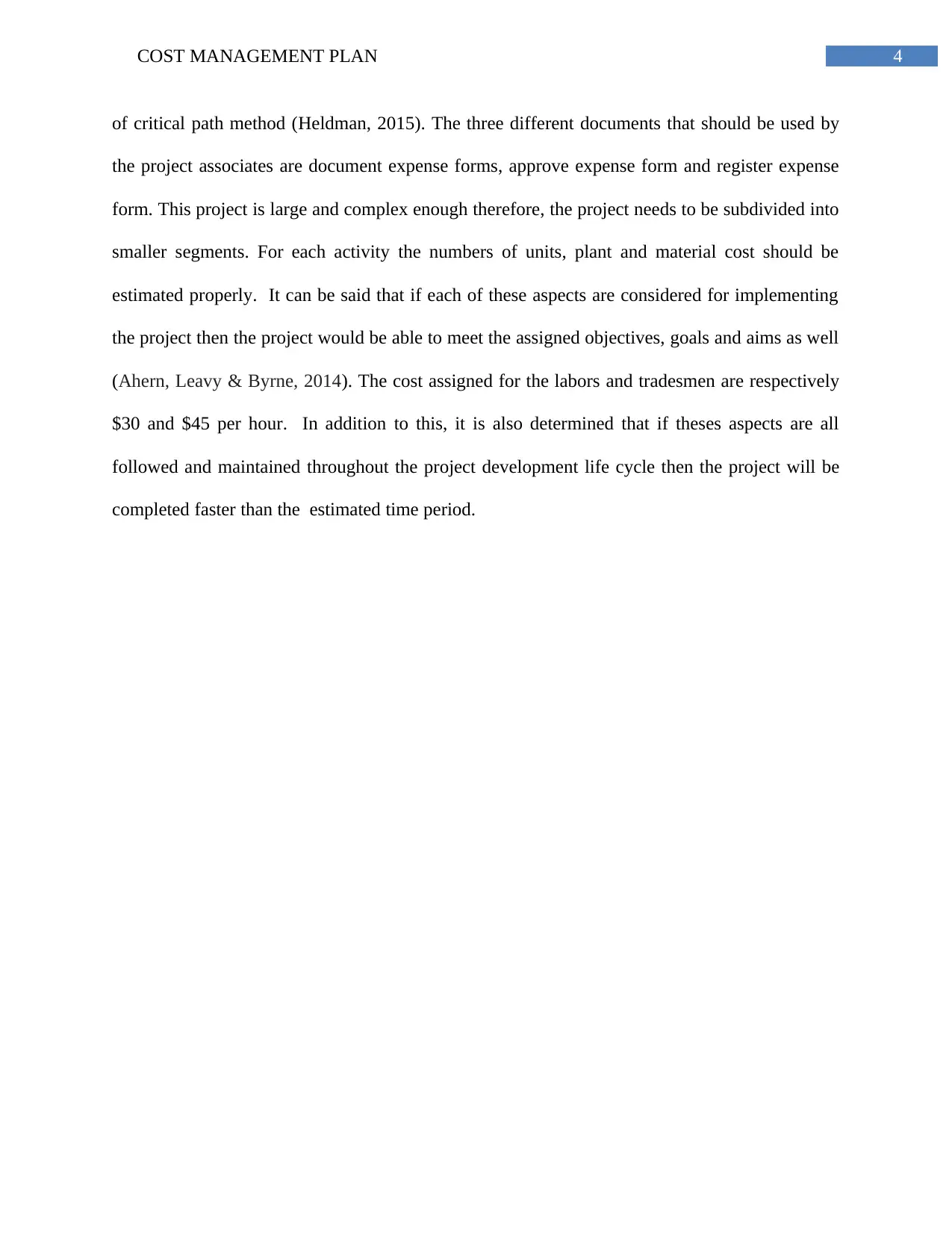
4COST MANAGEMENT PLAN
of critical path method (Heldman, 2015). The three different documents that should be used by
the project associates are document expense forms, approve expense form and register expense
form. This project is large and complex enough therefore, the project needs to be subdivided into
smaller segments. For each activity the numbers of units, plant and material cost should be
estimated properly. It can be said that if each of these aspects are considered for implementing
the project then the project would be able to meet the assigned objectives, goals and aims as well
(Ahern, Leavy & Byrne, 2014). The cost assigned for the labors and tradesmen are respectively
$30 and $45 per hour. In addition to this, it is also determined that if theses aspects are all
followed and maintained throughout the project development life cycle then the project will be
completed faster than the estimated time period.
of critical path method (Heldman, 2015). The three different documents that should be used by
the project associates are document expense forms, approve expense form and register expense
form. This project is large and complex enough therefore, the project needs to be subdivided into
smaller segments. For each activity the numbers of units, plant and material cost should be
estimated properly. It can be said that if each of these aspects are considered for implementing
the project then the project would be able to meet the assigned objectives, goals and aims as well
(Ahern, Leavy & Byrne, 2014). The cost assigned for the labors and tradesmen are respectively
$30 and $45 per hour. In addition to this, it is also determined that if theses aspects are all
followed and maintained throughout the project development life cycle then the project will be
completed faster than the estimated time period.
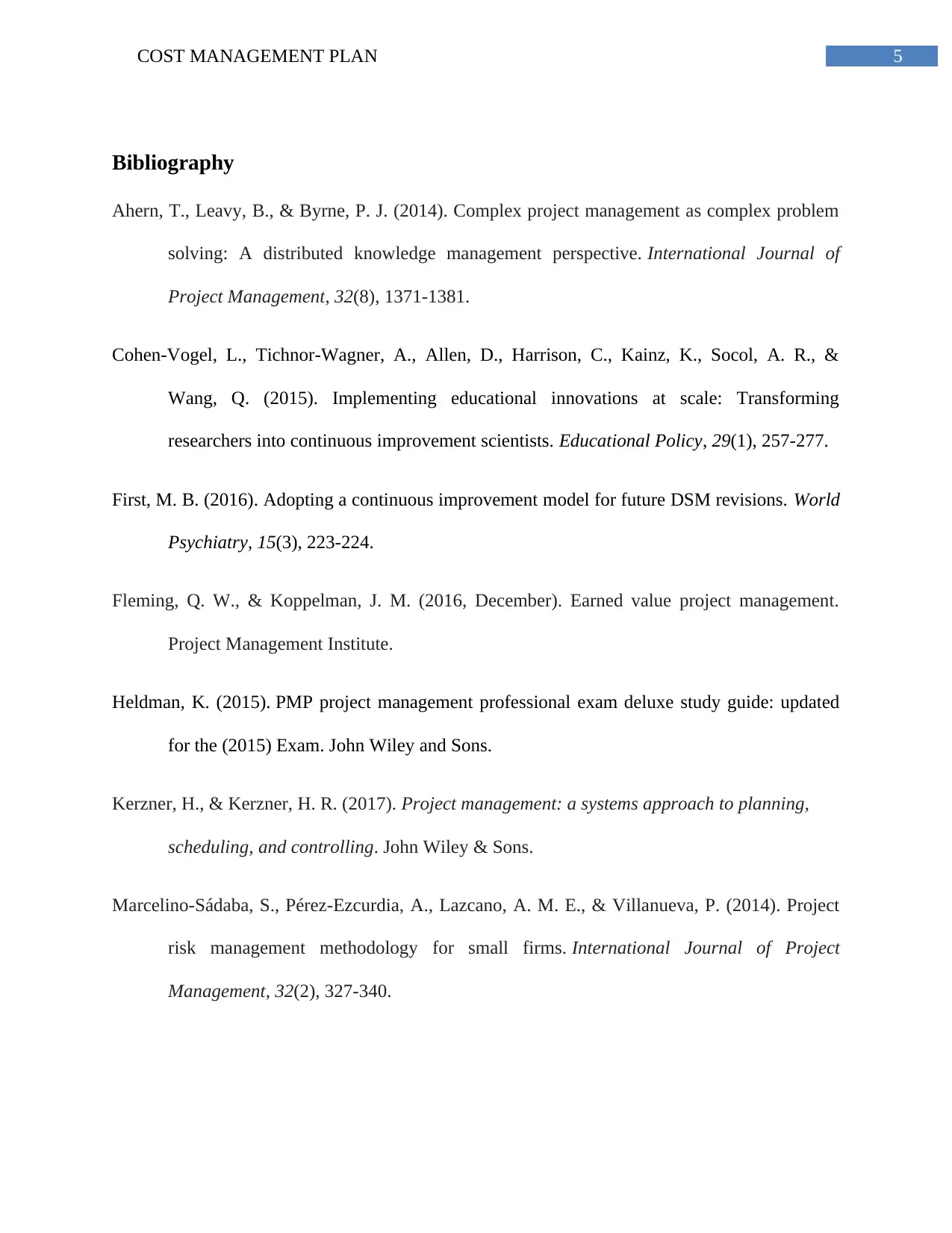
5COST MANAGEMENT PLAN
Bibliography
Ahern, T., Leavy, B., & Byrne, P. J. (2014). Complex project management as complex problem
solving: A distributed knowledge management perspective. International Journal of
Project Management, 32(8), 1371-1381.
Cohen-Vogel, L., Tichnor-Wagner, A., Allen, D., Harrison, C., Kainz, K., Socol, A. R., &
Wang, Q. (2015). Implementing educational innovations at scale: Transforming
researchers into continuous improvement scientists. Educational Policy, 29(1), 257-277.
First, M. B. (2016). Adopting a continuous improvement model for future DSM revisions. World
Psychiatry, 15(3), 223-224.
Fleming, Q. W., & Koppelman, J. M. (2016, December). Earned value project management.
Project Management Institute.
Heldman, K. (2015). PMP project management professional exam deluxe study guide: updated
for the (2015) Exam. John Wiley and Sons.
Kerzner, H., & Kerzner, H. R. (2017). Project management: a systems approach to planning,
scheduling, and controlling. John Wiley & Sons.
Marcelino-Sádaba, S., Pérez-Ezcurdia, A., Lazcano, A. M. E., & Villanueva, P. (2014). Project
risk management methodology for small firms. International Journal of Project
Management, 32(2), 327-340.
Bibliography
Ahern, T., Leavy, B., & Byrne, P. J. (2014). Complex project management as complex problem
solving: A distributed knowledge management perspective. International Journal of
Project Management, 32(8), 1371-1381.
Cohen-Vogel, L., Tichnor-Wagner, A., Allen, D., Harrison, C., Kainz, K., Socol, A. R., &
Wang, Q. (2015). Implementing educational innovations at scale: Transforming
researchers into continuous improvement scientists. Educational Policy, 29(1), 257-277.
First, M. B. (2016). Adopting a continuous improvement model for future DSM revisions. World
Psychiatry, 15(3), 223-224.
Fleming, Q. W., & Koppelman, J. M. (2016, December). Earned value project management.
Project Management Institute.
Heldman, K. (2015). PMP project management professional exam deluxe study guide: updated
for the (2015) Exam. John Wiley and Sons.
Kerzner, H., & Kerzner, H. R. (2017). Project management: a systems approach to planning,
scheduling, and controlling. John Wiley & Sons.
Marcelino-Sádaba, S., Pérez-Ezcurdia, A., Lazcano, A. M. E., & Villanueva, P. (2014). Project
risk management methodology for small firms. International Journal of Project
Management, 32(2), 327-340.
⊘ This is a preview!⊘
Do you want full access?
Subscribe today to unlock all pages.

Trusted by 1+ million students worldwide
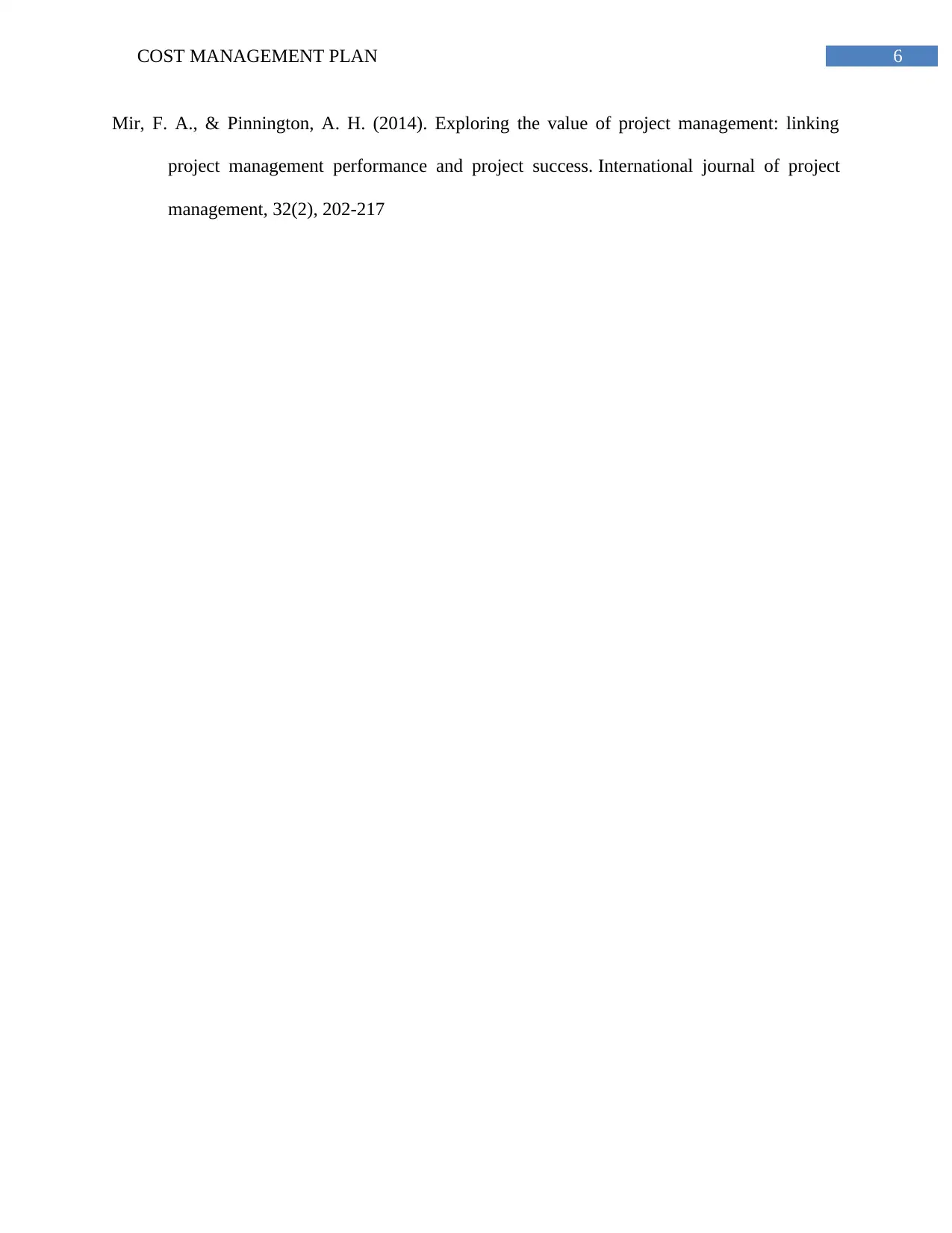
6COST MANAGEMENT PLAN
Mir, F. A., & Pinnington, A. H. (2014). Exploring the value of project management: linking
project management performance and project success. International journal of project
management, 32(2), 202-217
Mir, F. A., & Pinnington, A. H. (2014). Exploring the value of project management: linking
project management performance and project success. International journal of project
management, 32(2), 202-217
1 out of 7
Related Documents
Your All-in-One AI-Powered Toolkit for Academic Success.
+13062052269
info@desklib.com
Available 24*7 on WhatsApp / Email
![[object Object]](/_next/static/media/star-bottom.7253800d.svg)
Unlock your academic potential
Copyright © 2020–2025 A2Z Services. All Rights Reserved. Developed and managed by ZUCOL.





